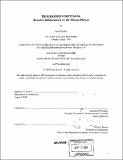Programmed emptiness : research infrastructure on the Tibetan plateau
Author(s)
Dunbar, Sarah (Sarah Ford)
DownloadFull printable version (95.20Mb)
Other Contributors
Massachusetts Institute of Technology. Dept. of Architecture.
Advisor
Alexander D'Hooghe.
Terms of use
Metadata
Show full item recordAbstract
The recent completion of a rail line running from central China to Lhasa in the Tibet Autonomous Region has brought attention not only to China's Architecture and Urbanism questionable occupation of Tibet, but also to the face that modernization in the TAR has adopted and the accompanying implications of China's large infrastructural projects in the TAR and other provinces. The thesis asserts that the form of development that has been propagated in Tibet has been modernizing in terms of economic growth and the incorporation of Tibet into networks of moving capital, people, and goods, but not actually modern, as Tibetans have generally been forced to the sidelines in the development of Tibet, serving more as indigenous tourist attractions than active participants in the shaping of a modern culture. The resulting condition is a present day state that is at once premodern and postmodern, consisting of a population that is still rooted in ancient traditions but very much a part of the society of the spectacle. This contradictory condition is heightened by Tibet's tourism industry, which caters to those visiting Tibet for its larger than life landscape features, unique and ubiquitous religion, and what is perceived as an authentic folk culture. The highly controlled route of the tourist in Tibet becomes, to some extent, a site where Tibet happens. Beyond the tourist route there are nomads, farmers, vast landscapes (and extreme poverty), but also a growing network of mines, power plants, military sites, dumps, prisons, and other peripheral ...
Description
Thesis (M. Arch.)--Massachusetts Institute of Technology, Dept. of Architecture, 2008. Includes bibliographical references (p. 194-195).
Date issued
2008Department
Massachusetts Institute of Technology. Department of ArchitecturePublisher
Massachusetts Institute of Technology
Keywords
Architecture.
